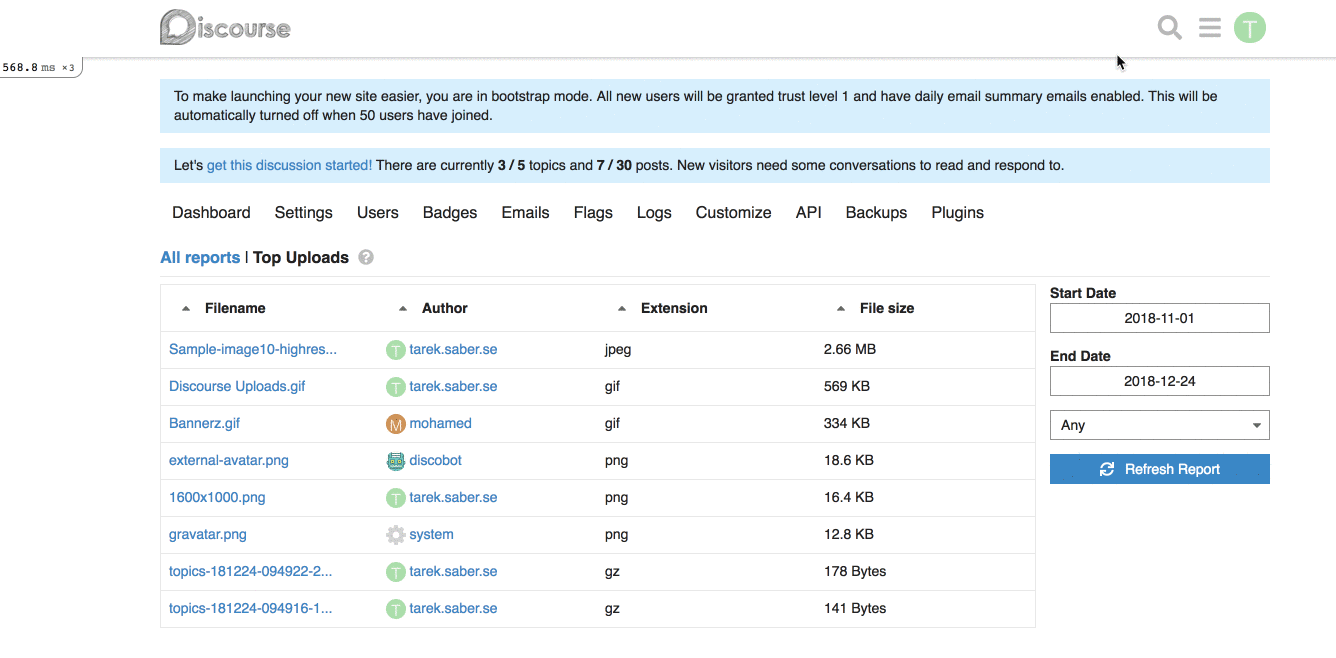This will allow users installing a Discourse PWA to use their active
theme colors on the generated app. Thanks for @mgiuca for the tip.
Also makes the share_target config explicit to silence Chrome warnings
Migrates email user options to a new data structure, where `email_always`, `email_direct` and `email_private_messages` are replace by
* `email_messages_level`, with options: `always`, `only_when_away` and `never` (defaults to `always`)
* `email_level`, with options: `always`, `only_when_away` and `never` (defaults to `only_when_away`)
* FEATURE: Exposing a way to add a generic report filter
## Why do we need this change?
Part of the work discussed [here](https://meta.discourse.org/t/gain-understanding-of-file-uploads-usage/104994), and implemented a first spike [here](https://github.com/discourse/discourse/pull/6809), I am trying to expose a single generic filter selector per report.
## How does this work?
We basically expose a simple, single generic filter that is computed and displayed based on backend values passed into the report.
This would be a simple contract between the frontend and the backend.
**Backend changes:** we simply need to return a list of dropdown / select options, and enable the report's newly introduced `custom_filtering` property.
For example, for our [Top Uploads](https://github.com/discourse/discourse/pull/6809/files#diff-3f97cbb8726f3310e0b0c386dbe89e22R1423) report, it can look like this on the backend:
```ruby
report.custom_filtering = true
report.custom_filter_options = [{ id: "any", name: "Any" }, { id: "jpg", name: "JPEG" } ]
```
In our javascript report HTTP call, it will look like:
```js
{
"custom_filtering": true,
"custom_filter_options": [
{
"id": "any",
"name": "Any"
},
{
"id": "jpg",
"name": "JPG"
}
]
}
```
**Frontend changes:** We introduced a generic `filter` param and a `combo-box` which hooks up into the existing framework for fetching a report.
This works alright, with the limitation of being a single custom filter per report. If we wanted to add, for an instance a `filesize filter`, this will not work for us. _I went through with this approach because it is hard to predict and build abstractions for requirements or problems we don't have yet, or might not have._
## How does it look like?

## More on the bigger picture
The major concern here I have is the solution I introduced might serve the `think small` version of the reporting work, but I don't think it serves the `think big`, I will try to shed some light into why.
Within the current design, It is hard to maintain QueryParams for dynamically generated params (based on the idea of introducing more than one custom filter per report).
To allow ourselves to have more than one generic filter, we will need to:
a. Use the Route's model to retrieve the report's payload (we are now dependent on changes of the QueryParams via computed properties)
b. After retrieving the payload, we can use the `setupController` to define our dynamic QueryParams based on the custom filters definitions we received from the backend
c. Load a custom filter specific Ember component based on the definitions we received from the backend
* First take
* Add support for sprites in themes
Automatically register any custom icons added via themes or plugins
* Fix theme sprite caching
* Simplify test
* Update lib/svg_sprite/svg_sprite.rb
Co-Authored-By: pmusaraj <pmusaraj@gmail.com>
* Fix /svg-sprite/search request
Since uploads site settings are now backed by an actual upload, we don't
have to reach over the network just to fetch the favicon. Instead, we
can just read the upload directly from disk.
Attempt to force NGINX to include content length when doing X-SendFile
This does not seem to be required when bypassing NGINX.
Without this header some CDNs may have issues caching
When a new post is triggered via message bus post stream will attempt to load
it, previously the `/topic/TOPIC_ID/posts.json` would unconditionally include
suggested topics, this caused excessive load on the server.
New pattern defaults to exclude suggested and related topics from this API
unless people explicitly ask for suggested.
Do not allow `/u/search/users.json` to list any group matches unless a
specific `term` is specified in the API call.
Adding groups should always be done when an actual search term exists,
blank search is only supported for users within a topic
Co-authored-by: Sam Saffron <sam.saffron@gmail.com>
Co-authored-by: David Taylor <david@taylorhq.com>
This gives more control over the request. In particular we can easily
lookup DNS dynamically, instead of only upon NGINX startup.
Previously, NGINX was looking up IP for the letter avatar service and
caching the CDN IP address, this caused issues if CDN changed IP, in
which letter avatars would be broken till a container restarted.
NGINX config has been updated to add caching. This change will require
a container rebuild.
The proxy will now function in development environments, so the patch
for `letter_avatar_proxy` has been removed.
We had a missing formats: string on our render partial that caused logs to
spam when CSS files got 404s.
Due to magic discourse_public_exceptions.rb was actually returning the
correct 404 cause it switched format when rendering the error.
Previously it would unhide their post but leave them silenced.
This fix also cleans up some of the helper classes to make it easier
to pass extra data to the silencing code (for example, a link to the
post that caused the user to be silenced.)
This patch also refactors the auto_silence specs to avoid using
stubs.
Currently the theme is matched by name, which can be fragile when there are many themes with the same name. This functionality will be used by the next version of theme CLI.
If for some reason `Discourse.store.path_for` returns `nil`, the
forum would throw an error rather than returning 404.
Why would it be `nil`? One cause could be changing the type of
file store and having the `url` field no longer be relative.